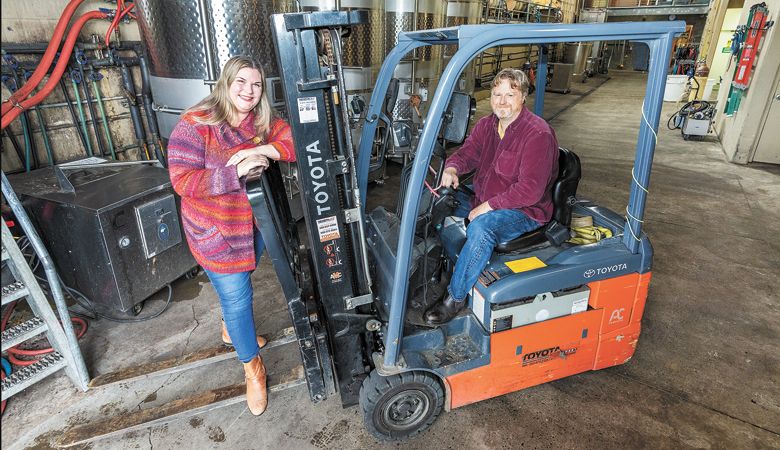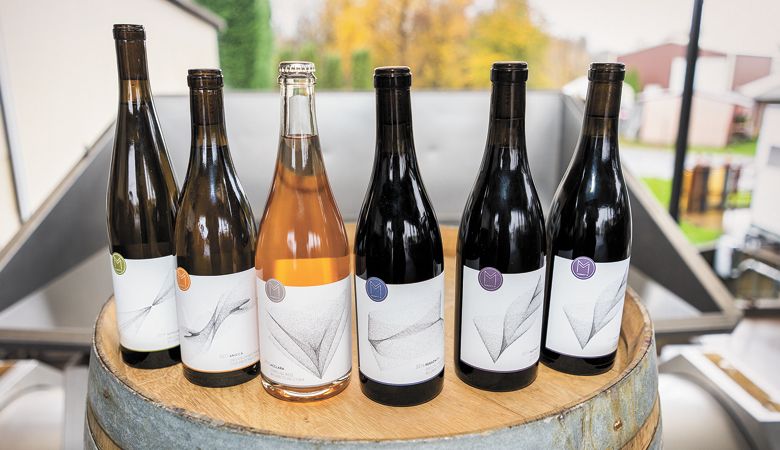Project Magnific
Murrays build brand on expertise, fine-tuned philosophy
McMinnville winemaker Jerry Murray knows exactly what he wants in his wines: “purity, precision, elegance and transparency.” These are the hallmarks of Project M Wines, an enterprise he started in 2016 with wife Meg.
Sourcing fruit from eight vineyards in the Willamette Valley, Project M produces wines at The Carlton Winemakers Studio. The “M” stands for the roman numeral (1,000), representing the seemingly number of decisions that goes into each bottle. He currently makes 1,100 cases with plans to expand to 10,000. There’s no timeline; Murray just intends to do it.
Besides, he has the goods.
“Our portfolio [represents] wines that best express those four qualities,” he explains. His main varieties — Pinot Noir, Riesling, Chardonnay and sparkling rosé — fit the bill. Since Project M’s first vintage five years ago, Murray has earned consistent scores in the 90s.
His approach to winemaking explains the ascending arc.
“I believe the most critical decision in winemaking is when to pick,” he emphasizes. “I’m out in the vineyard a lot after first bloom. Ripening is a reproductive rhythm, and I carefully track the gestation of the grapes months and weeks before harvest.” He adds, “Ninety percent of winemaking is working with great farmers and getting amazing fruit.”
The common denominator for him and those who run the vineyards he selects is “attention to timing and detail, and a focus on leaf pulling and crop control.”
Regarding the crafting of reds, he says, “Winemaking is architectural. We’re building structures with the wine’s intrinsic components. I manage the extraction of color and tannin, the frame of the structure, in a manner specific to each site and season. I use oak components, exclusively from French forests, to add aromatic nuance as well as structural material to the wine.”
Murray continues, “Delayed malolactic fermentation gives oxygen time to catalyze the building of the wines’ scaffolding. Aging on lees and, in some cases, lees stirring contribute to the structure's fine exterior.” This technique was especially important for the 2018 Pinot Noir vintage as the fruit was slightly underdeveloped.
For whites, Murray explains, “The work is to polish and wrap the wine’s core of acidity so it’s free of barbs and burrs yet retains tension and acceleration. I’ll give some of the wines, especially Chardonnay, an influence of oak. That’s intended to serve a supporting role, never the star.” He adds, “Lees management is specific to each wine, so the aromatic, textural and energetic contribution is appropriate to the style.”
For Murray, purity translates to “a sort of complexity through simplicity, emphasizing the essence of grape and vineyard interaction.” Regarding precision, “I like wines with clearly defined features, knowing where they begin and end,” he says. “A precise wine is one that’s well-structured with clear, unobstructed features.”
As for elegance, Murray is not referring to “light” wines. He explains, “To me, it’s what is needed to make a wine whole but nothing more. I don’t want to make wines that yell but ones that speak in a conversational tone.” Transparency is about wine’s ability to tell a story. “They reflect the grape and place they came from, the season and the winemakers’ influence who made it.” He adds, “Riesling and Pinot Noir give no place to hide. But Chardonnay demands a winemaker who tells it what to be.”
Back to the Beginning
Approaching his 25th vintage, Murray smiles as he explains his professional past. Born and raised in rural Ohio, he earned a degree in physiology at Ohio University’s College of Osteopathic Medicine. On a path to become a teacher in that specialty, he realized academia wasn’t the right fit. “It was too much left brain over right brain; not a balance.”
Next, a budding culinary career, from line cook to promising chef. At Tucson’s Fuego Restaurant, he worked with chef Alan Zeman, helping organize wine dinners with sommeliers. His not-so-slumbering wine passion was awakening. Like before, the kitchen was not the right path either. Murray was being called to the cellar.
He realized making wine was the profession that gave him the best right/left brain balance. His impressive wine resumé starts with Erath Winery and rolls on from there, including Panther Creek in McMinnville, Chehalem Wines in Newberg, Patton Valley in Gaston and Van Duzer in Dallas. He has worked abroad, too, with harvests at Highfield Estate and Martinborough Vineyard in New Zealand, and Selbach-Oster in Germany’s Mosel Valley.
With many years’ experience, Murray was hired by a sparkling powerhouse in 2013. He accepted a position as the inaugural winemaker for Domaine Anderson, located in Philo, California, and owned by Champagne’s Louis Roederer. He worked with famed Burgundy winemaker Jeremy Seysses to create expressive, individualistic Pinot Noir and Chardonnay.
He enjoyed the work but ultimately decided to strike out on his own. The Murrays returned to the green lushness of the Willamette Valley and his longtime wine community.
With no brick-and-mortar winery or a vineyard of their own — that’s the dream ahead — the Murrays continue to thrive in a challenging wine market, especially for boutique wineries.
All wines told, Project M is poised to leap ahead. And when the time comes, the couple promises “a tasting room that will deliver compelling and unique experiences.” Judging from the wines made and philosophy followed, fans have no doubt it will be amazing and worth the wait.











